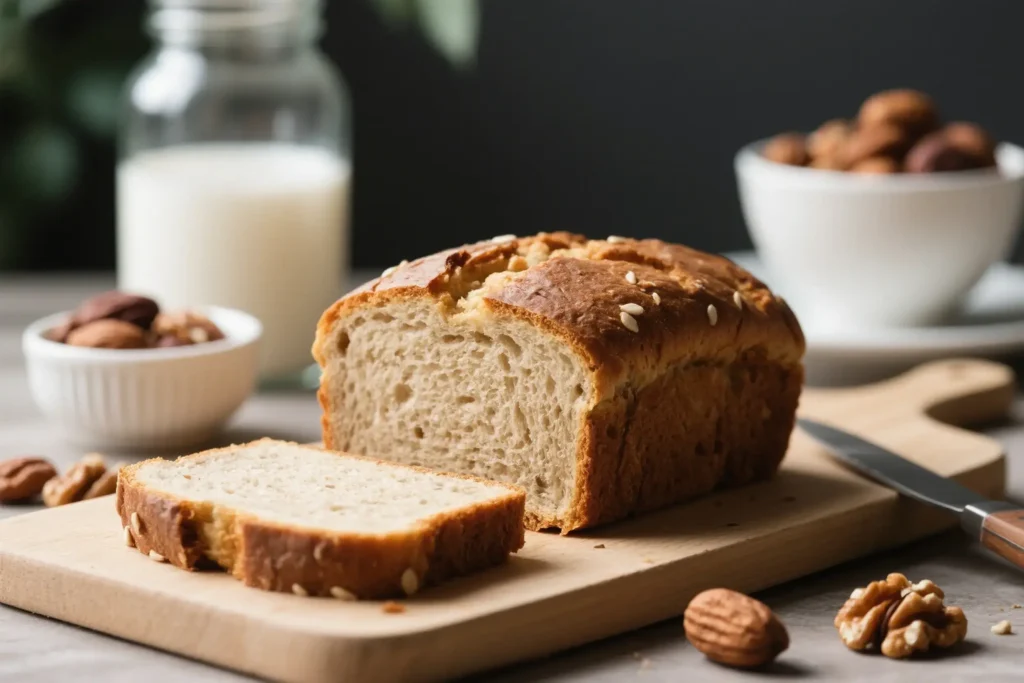There’s something magical about the moment rosemary parmesan bread comes out of your oven. That golden crust, the scent of freshly baked bread mingling with earthy herbs and warm cheese, it’s more than just food. It’s a memory waiting to be made. Baking rosemary parmesan bread from scratch isn’t just about nourishment. It’s about slowing down, embracing the present, and filling your home with a warmth that only homemade bread can offer. You don’t need to be a professional baker to experience this joy. All you need is time, a little guidance, and the willingness to dive in.
You might remember a time when you walked into a bakery and caught that rich aroma of parmesan mingling with herbs. That moment may have stayed with you. Now, imagine creating that same comforting feeling in your own kitchen. With this guide, you’ll discover how rosemary parmesan bread becomes more than a recipe. It becomes your go-to tradition, your comforting classic, and your ultimate homemade masterpiece.
The Irresistible Allure of Rosemary Parmesan Bread
You’re not just baking another loaf. You’re baking a creation that combines simplicity with elegance. Rosemary parmesan bread brings together the depth of aged cheese with the aromatic punch of fresh rosemary, making every bite a burst of flavor. This isn’t a flavor combination that fades in the background. Instead, it holds center stage on your table.
You’ll notice how the rosemary adds a savory, almost pine-like note that plays off the nutty sharpness of parmesan. Together, they transform your bread from a plain side to a show-stopping centerpiece. Whether you’re pairing it with soup, salad, or enjoying it on its own with a smear of butter, this rosemary parmesan bread will always impress.
This bread also has a rustic charm. It feels artisan, homemade, and handcrafted with love. It’s the kind of bread you serve when guests come over and they ask for the recipe after the first bite. It’s also the kind of bread that makes you feel proud, knowing you created something so rich in flavor and character.
Baking Rosemary Parmesan Bread: A Sensory Experience

Baking rosemary parmesan bread is more than a kitchen task. It’s an experience that engages all your senses. You start with a simple mixture of flour, water, and yeast. As the dough comes together, you feel its softness. You watch it rise, slowly and confidently, doubling in size as if it knows how good it will become.
Once you fold in the rosemary and parmesan, the transformation begins. Suddenly the dough becomes fragrant. As it bakes, your home fills with the scent of warm herbs and bubbling cheese. The crust turns golden, the top cracks slightly, and you know you’re close. Then there’s that satisfying sound when you slice through the loaf. A crisp shell gives way to a soft, flavorful center.
You’ll enjoy this bread with your eyes first. The parmesan melts into golden patches. The rosemary weaves green flecks throughout the crumb. And when you finally take that first bite, you’ll understand. The flavor is savory, cheesy, herbaceous, and full-bodied. You taste the love and patience that went into every step.
Sensory Highlights:
- Texture: Crispy crust, soft chewy interior
- Aroma: Fragrant with rosemary and toasted cheese
- Appearance: Golden top with a rustic look and herb flecks
- Taste: Savory, slightly salty, deeply satisfying
Tools and Tips for Baking Perfect Rosemary Parmesan Bread
To create the best rosemary parmesan bread, having the right tools makes a difference. These essentials help you work with the dough more efficiently and ensure a consistent bake every time.
Must-Have Tools:
- A large mixing bowl for the dough
- A sturdy dough scraper to handle sticky dough
- A kitchen scale for precise ingredient measurements
- A Dutch oven or baking stone for that perfect crust
- A sharp knife or lame for scoring the dough before baking
Proven Tips for Success:
- Use fresh rosemary for stronger flavor and aroma
- Always grate your parmesan cheese fresh to avoid a waxy texture
- Don’t rush the rise. Good bread needs time to develop structure and depth
- Let your dough rest between stretches to build strong gluten
- Preheat your Dutch oven in the oven before baking for a bakery-style crust
When you take your time and follow these tips, your rosemary parmesan bread will consistently turn out beautifully. It’s a mix of science and art, and with practice, you’ll master both.
Step-by-Step Guide to Crafting Your Bread Masterpiece
Creating rosemary parmesan bread might feel like a big task, but when you break it down, it becomes manageable and even enjoyable. Each phase of the process has its role in building flavor and texture. Here’s how you bring it all together.
1. Prepare Your Dough
Start by combining your flour, yeast, salt, and water. Mix just until the dough comes together, then knead gently. You’re looking for a dough that’s soft and slightly sticky. Don’t over-knead or add too much flour. Let the dough relax and work with it as it is.
2. Let the Dough Rise
Cover your dough and let it rise in a warm place until it doubles in size. This usually takes about 1 to 2 hours. You’ll know it’s ready when you press your finger into it and the dough doesn’t bounce back quickly.
3. Incorporate Rosemary and Parmesan
Gently fold in the chopped rosemary and grated parmesan. Don’t mix too hard. You want even distribution without deflating the dough. The cheese and herbs should become part of the dough, not sit on top.
4. Shape the Loaf and Let It Rise Again
Shape your dough into a round or oval loaf. Place it seam side down on parchment. Cover and let it rest again for about 30 to 45 minutes. This second rise builds a lighter texture.
5. Bake Your Bread
Place your loaf into a hot Dutch oven or onto a baking stone. Score the top to allow controlled expansion. Bake with the lid on for the first half, then remove it to allow browning. You’re looking for a deep golden crust and a hollow sound when tapped.
When your rosemary parmesan bread comes out, resist slicing right away. Let it cool for at least 20 minutes to finish setting the crumb. Then slice and enjoy the reward of your work.
Homemade Breads to Bake Today
- Soft and Simple Lavash Bread: Thin, tender, and perfect for wraps or snacking
- Amish Cinnamon Swirl Bread: Sweet, soft, and filled with cozy cinnamon goodness
- Easy Date Nut Bread: Rich, moist, and naturally sweetened with dates
Serving Suggestions: Elevate Your Meals with Rosemary Parmesan Bread

You might wonder how to enjoy rosemary parmesan bread beyond just butter. The truth is, it’s incredibly versatile and adds richness to so many meals. Here are some delicious pairings and uses to inspire you.
Creative Ways to Serve:
- Slice and toast with garlic butter for a savory appetizer
- Use as sandwich bread for roasted turkey or grilled vegetables
- Serve with soups like tomato basil or creamy mushroom
- Cube and bake for crunchy, herbed croutons
- Pair with olive oil, balsamic vinegar, and cured meats on a charcuterie board
Your rosemary parmesan bread doesn’t just sit on the table. It elevates every bite of your meal. Whether you enjoy it warm out of the oven or toasted the next day, it always delivers comfort and satisfaction.
Troubleshooting Common Baking Issues
Even the best bakers hit a few snags now and then. When making rosemary parmesan bread, you might run into a few bumps along the way. Here’s how to fix them and get back on track.
Common Problems and Fixes:
- Dry Bread: Check your dough hydration. Add a little more water during mixing if it feels too stiff.
- Dense Texture: This often means the dough didn’t rise long enough or wasn’t kneaded properly. Let it rest longer and try gentle stretches instead of aggressive kneading.
- Bitter Aftertaste: Be careful not to use too much rosemary. A little goes a long way.
- Burnt Crust: Try lowering your oven temperature or covering the loaf loosely with foil in the last 10 minutes.
- Flat Loaf: The dough may have over-proofed or lacked surface tension during shaping. Shape tightly and avoid letting it rise too long on the second proof.
You’ll learn from every loaf, and soon enough, baking rosemary parmesan bread will feel as natural as boiling water.
Storing and Freezing Your Bread for Later
Your rosemary parmesan bread is too good to let go to waste. The right storage keeps it fresh for days and ready to enjoy anytime.
How to Keep It Fresh:
- Cool the bread completely before wrapping
- Store at room temperature in a paper bag or bread box for up to two days
- For longer storage, slice and freeze in a zip-sealed bag
- Reheat frozen slices in a toaster or oven for a fresh-baked feel
This way, you’ll always have rosemary parmesan bread ready for your meals. It freezes beautifully and toasts up with flavor intact.
Health Benefits of Homemade Rosemary Parmesan Bread
Baking your own rosemary parmesan bread isn’t just about taste. It’s also a better choice for your well-being. When you control the ingredients, you improve the quality of what you eat.
Benefits You’ll Enjoy:
- No preservatives or artificial additives
- Lower sodium options by adjusting cheese and salt
- Fresh rosemary contains antioxidants and anti-inflammatory properties
- Parmesan adds calcium, protein, and umami without excess fat
Homemade bread supports mindful eating. You savor each slice because you know exactly what’s in it and how it was made.

Best Rosemary Parmesan Bread You’ll Ever Bake
Equipment
- Large mixing bowl
- Dough scraper
- Kitchen scale
- Dutch oven or baking stone
- Sharp knife or lame for scoring
Ingredients
- 4 cups all-purpose flour about 480 grams
- 1 packet active dry yeast 2 ¼ teaspoons
- 1 ½ teaspoons salt
- 1 ¾ cups warm water about 110°F / 43°C
- 2 tablespoons fresh rosemary finely chopped
- 1 cup freshly grated Parmesan cheese
- 2 tablespoons olive oil optional, for extra flavor and softness
- Extra flour for dusting
Instructions
- Prepare your dough by combining flour, yeast, salt, and water. Mix until dough forms, then knead gently until soft and slightly sticky.
- Let the dough rise in a warm place until doubled in size, about 1 to 2 hours.
- Fold in chopped fresh rosemary and freshly grated parmesan cheese gently to distribute evenly.
- Shape the dough into a round or oval loaf. Place seam side down on parchment paper and cover. Let it rise again for 30 to 45 minutes.
- Preheat the oven and Dutch oven or baking stone. Score the top of the dough for controlled expansion.

- Bake with the lid on for the first half, then remove the lid to brown the crust until deep golden and crisp.
- Remove the bread and cool for at least 20 minutes before slicing.
Notes
Frequently Asked Questions
Is rosemary parmesan bread difficult to make?
Not at all. You can make this bread even if you’re a beginner. Follow each step carefully, give the dough time to rise, and you’ll have bakery-quality results.
Can I substitute dried rosemary for fresh?
Yes, just use less. Dried herbs are more concentrated. A good rule is one teaspoon of dried rosemary for every tablespoon of fresh.
What’s the best substitute for parmesan?
If you don’t have parmesan, try Pecorino Romano or Asiago. Both give you a sharp, salty flavor that mimics parmesan well.
How do I know the bread is baked through?
Tap the bottom of the loaf. It should sound hollow. You can also check that the internal temperature reaches 190 to 200 degrees Fahrenheit.
Can I make this bread gluten-free?
Yes, but you’ll need a special gluten-free flour blend and possibly xanthan gum to get the texture right. The rise and bake time may differ slightly.
Conclusion: The Joy of Baking the Best Rosemary Parmesan Bread
Now that you know what makes rosemary parmesan bread truly unforgettable, it’s time to create your own. Every loaf tells a story. It’s about more than flour and cheese. It’s about the intention you bring to your kitchen and the memories you create for yourself and those you love.







Pingback: Soft And Sweet Amish Cinnamon Swirl Bread - 2025